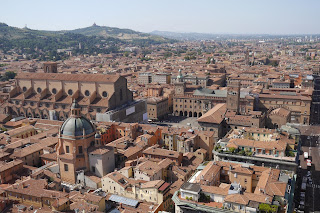The Torre degli Asinelli
We are staying the north of the city and so we have no real option but to start by repeating the first mile of yesterday's walk. At the crossroads by Piazza Nettuno we turn left towards our initial destination: the Asinelli Tower, which can be seen at the end of the street. There are in fact two towers - the other, the Torre della Garesinda, can just be glimpsed on the left.
As we are heading towards the towers we become aware of a beautiful cupola rising above the roof tops to our right and we head into the maze of small streets where the food market it is to find it. Eventually we do: it is the church of Santa Maria della Vita, rebuilt, with the cupola in the late 17th century. Unfortunately it is so hemmed in by buildings, that we can't actually see the cupola.
We head towards the two towers from a different angle, passing the dramatic, and beautifully ornamented, Palazzo della Mercanzia, the Chamber of Commerce. It was built in 1382-4.
It is a short way from the Palazzo della Mercanzia to the two towers and from a point just beyond them the contrast becomes clearer. The Torre degli Asinelli dates from 1109-19 and is nearly 100m high. It is 1.23m out of the perpendicular. The Torre della Garesinda is contemporary, but was never finished and was shortened for safety reasons in 1351-60. It is now only 48m high and is 3.22m out of true.
We climb the 500 steps to the top of the Torre degli Asinelli. The view from the top is stupendous. In the foreground is the elusive cupola of Santa Maria della Vita, with the Basilica of San Petronio behind it. The twin Piazzas, Maggiore and del Nettuno, are to the right of the basilica. The sanctuary of the Madonna di San Luca can be seen on its hill in the background. It is connected to the city by a 17th century portico of 666 arches.
We now wandered through the former Jewish ghetto, which includes the splendidly named via dell'Inferno - Hell St - and some interesting buildings.
We paused for lunch at the excellent and very friendly Nicola's restaurant just by the church of San Martino, with its 14th century gothic pinnacles.
After lunch we wander though the Univeristy area to reach the Pinacoteca Nazionale, a wonderful art gallery. It is not much from the outside, although this interior courtyard with its renaissance well-head is very pleasing.
Inside there is a fine collection of pre-Renaissance and Renaissance paintings. The official highlights are a triptych by Giotto, one of only three works signed by the artist, and Raphael's St Cecilia. We were especially taken by a fresco of Paradiso e inferno (Heaven and Hell) by the Maestro dell' Avicenna. It depicts heaven and hell in an almost identical fashion to the wonderful frescoes by Givanni di Modena that we saw yesterday in San Petronio.
Our final stop was the exquisite Santo Stefano complex - one of the things we remember most vividly from our first visit to Bologna in 1995. Viewed from the square there are three interconnecting separate churches, and there are others behind. The earliest dates from 392. Dante apparently meditated here in 1287.
The wonderful romanesque church on the left, San Vitale and San Agicola, was unfortunately closed for restoration, but we admired the decorated brickwork on the rear of the Holy Sepulchre church (in the middle). The church is dominated inside by the elaborate tomb of San Petronio.
The cloister too was a delight.
We emerged into piazza in the late afternoon sunshine and headed back to our hotel.
Conditions: hot and sunny.
Distance: 5 or so miles in all.
Rating: five stars.












No comments:
Post a Comment